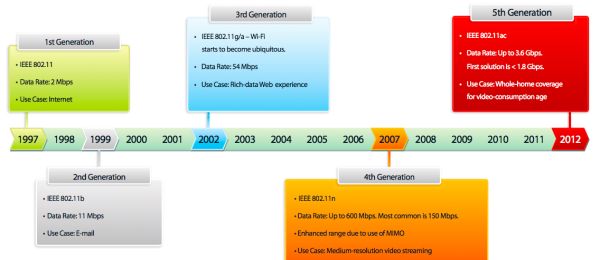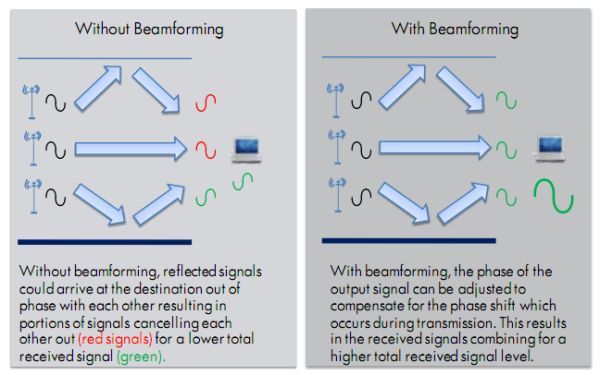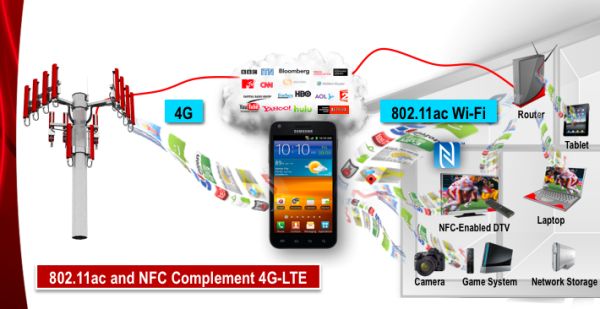Five years have passed since the first 802.11n devices implementing a draft of the now-finalized specification hit the market. Over the years 802.11n support has become ubiquitous in the industry. Everything from smartphones to high-end notebooks support the standard. Even low cost products like the $99 Apple TV or $49 Roku LT ship with 802.11n support. With real world transfer speeds ranging from 30Mbps at the low end to 150Mbps at the high end, 802.11n is simply too slow to quickly move large files. It wasn't too long ago that 100MB/s was reserved for high-end hard drives in PCs. Today, with SSDs capable of sustaining transfers of over 500MB/s, the bottleneck in many wireless homes is increasingly becoming WiFi.
The IEEE has been working on the specification for the fifth generation of WiFi: 802.11ac. Today that spec is in its draft stages and is expected to be finalized by the end of 2012 or beginning of 2013. The first 802.11ac chipsets have
already been announced by Broadcom, with the first devices (routers, USB dongles, PCIe cards and OEM systems) shipping very shortly. Broadcom expects that the final version of the 802.11ac spec will be only marginally different from the current draft and any changes it expects to be able to address in software.
If you're wondering where the 'ac' suffix comes from, the IEEE simply ran out of single letters. Every technical paper released by the IEEE for the 802.11 project is assigned a letter. The vast majority of these papers aren't broad, networking standards which is why you never hear about them. The ones that end up as standards gain popularity but the nomenclature is purely linear use of the alphabet.
Note that 802.11ac is not the same as WiGig (802.11ad), which is a 60GHz interface with very short range. WiGig is more of an in-room technology while 802.11ac is a true WiFi successor.
5GHz Only, 256QAM
Although 802.11n can operate in either 2.4GHz or 5GHz modes, 802.11ac is exclusively a 5GHz interface. While there are building propagation tradeoffs made at higher frequencies, the benefit of being 5GHz-only is a significant reduction in interference. While the 2.4GHz spectrum is littered with interference from other devices, there's much less crowding at 5GHz where there's much more available spectrum. If you've ever been in an densely populated environment and tried to tether your notebook to your smartphone over 2.4GHz WiFi (anywhere in Manhattan) you'll appreciate 802.11ac's 5GHz exclusivity.
Each 802.11ac channel is wider than any previous WiFi standard at 80MHz with optional support for 160MHz (40MHz is the widest you can get on 802.11n, although 20MHz is still not uncommon).


64QAM (left) vs. 256QAM (right), Image Courtesy Wikipedia
802.11ac 3x3: Up to 1.3Gbps, Wirelessly
The 4x increase in data encoded on a carrier coupled with a doubling of channel bandwidth are together responsible for the increase in bandwidth per stream in 802.11ac. The maximum bandwidth per spatial stream in 802.11n was 150Mbps (40MHz channels, short guard interval), while in 802.11ac that value jumps to 433Mbps.
Smartphones and tablets will still likely use a 1x1:1 configuration (1 transmit, 1 receive antenna with 1 spatial stream), however high-end notebooks will likely use 3x3:3 configurations similar to what they have today with 802.11n. In these cases you're looking at a peak theoretical bandwidth of 1.3Gbps. Even with smartphones/tablets implementing 1x1:1 802.11ac (433Mbps), there's a huge improvement over the 72Mbps PHY rate on the best of the best today.
As we've seen with 802.11n, real world transfer rates are often 1/3 - 1/2 of the negotiated interface rate. Even if that continues to be the case, we're still looking at a tangible increase in bandwidth over 802.11n.
There is a chance we'll see even better efficiency out of 802.11ac however. Although closed loop beam forming was a supported feature in the 802.11n spec, it wasn't widely used. In 802.11ac, we'll see closed loop beam forming from many high-end, multi-antenna access points. Combined with information from client devices, 802.11ac APs will be able to adjust the phase of output signals to increase received signal strength on the client without increase output power on the AP.
802.11ac also supports more spatial streams (8) than 802.11n although the first solutions will still use a maximum of three.
Power Consumption
Given an infinitely sized data set, 802.11ac will draw more power than 802.11n. The specification is simply more complex and supporting things like wider channels requires more power. Thankfully, data sets are not infinitely sized. And for the near term, files and web pages sizes shouldn't increase tremendously. Although 802.11ac chipsets built on the same process as their n counterparts will draw more active power, their higher performance should allow the WiFi stack to go to sleep sooner. Idle power in a well designed 802.11ac solution should be comparable to 802.11n, and a race to sleep generally results in improved average power.
When faced with the prospects of significant improvements in download speeds, users tend to do more with their devices. If you're transacting more data over 802.11ac than you did via 802.11n, you can expect to see greater power consumption. If you're doing the same workload, it's possible that you'll see the same or better power consumption on 802.11ac compared to n thanks to the chipset being able to go to sleep quicker. All of this depends on the scenario, something we'll obviously test once we have the first ac devices in house.
The first 802.11ac chipsets will be built on 40/45nm processes, similar to the most recent 802.11n chipsets. The inevitable move to 28/32nm will further reduce power to help offset any changes in usage models over time, although I wouldn't expect that transition to happen for a little while given the cost of 28nm wafers today.
Backwards Compatibility
Similar to current 802.11n devices, ac chipsets will support fallback to older 802.11 standards depending on available networks and speeds. Chipsets are expected to prefer 5GHz ac by default, but then fall back to 802.11n speeds when appropriate. Most chipsets will likely be dual-band, so in the event that 5GHz isn't sustainable (or available) they will fall back to 2.4GHz 802.11n, then g and b.
Final Words
We're still a couple of years away from widespread adoption of 802.11ac, but the first products will be arriving shortly (many will likely debut at CES next week). We often write about advancements in CPU, GPU and SoC technologies, but it's important to see progress in network interfaces as well. Balanced systems are important and 802.11ac should help usher in the next-generation of usage models.
We'll enjoy the benefits of less interference as 802.11ac is a 5GHz-only standard as well as much higher performance thanks to wider channels and 256QAM encoding. Transmit power efficiency should also go up if we get wireless APs with sophisticated beam forming support. All of this will work together to deliver many times the performance we currently get over 802.11n without significant downsides.
WiFi has proven to be extremely important in the mobile revolution that has taken place over the past 10 years. While we'll undoubtedly see even faster wired interfaces (10GbE on the desktop anyone?), 802.11ac will be a significant part of the next phase of mobile evolution.















38 Comments
View All Comments
name99 - Thursday, January 5, 2012 - link
"Kinda disappointed to see the "feature" of 256QAM. Why not 1024QAM? Or 4096QAM..?"This is a silly comment. The ultimate limitation on how aggressively you can run your QAM is the SINR ratio. The noise floor is fixed, the interference level depends on your situation. Given the power limits on WiFi and the noise floor, this gives us how aggressively we can run QAM. I don't know the relevant numbers, but obviously if the power level/noise floor ratio were such that QAM256 is not feasible, it would not be part of the spec. Recall also that better decoding (eg using turbo codes, or even convolutional codes with turbo-inspired soft-value multi-pass algorithms rather than conventional viterbi decoding) allows one to approach closer to the theoretical noise limits.
Now perhaps you are in an environment where interference is high and constant, and so you're not going to be able to take advantage of such codes. But that is no reason to prevent others, who might be in quieter environments, from being able to utilize them.
A more interesting point, and I was upset the article did not discuss this, is whether the godawful 802.11 MAC has been improved in this spec. It is the MAC more than anything else that is responsible for the factor of a half or so that we always see in WiFi, even under the best conditions, between real world throughput and nominal throughput. The 802.11 committee seems always to be concerned with the extreme situation of a conference with two hundred people sharing a network, but never seems interested in the opposite (but much more common) situation of a home with a base station and usually one, occasionally two, devices trying to talk to the access point. This sort of home environment could utilize a managed MAC (controlled by the base station) and could practically double its throughput under most actual conditions.
MGSsancho - Thursday, January 5, 2012 - link
First thank you for bringing up 802.11n already has all the mentioned features except 246QAM. Thank you again for mentioning that the big changed from abg -> n were about 200 people in conferences as well as the need for a base station MAC.a few devices over a large area is more important to me honestly. If i need to populate a large area there are many vendors who sell amazing APs for that market ($$$ each.) What option is there for home users for need a large area and must use more than one AP? disable DHCP on the AP, same SSID and make them use channels 1, 6 and 11? ( many of my devices are limited to 2.4ghz.) what about dual radio APs under $200 so i can set this all up? some of use are forced to set up our own mesh network for home use. honestly very complicated if you want to stream pr0ns/many people play on hand held devices while walking about the place. Personal I use a microtik router with microtik software APs with a radio for each band then let the software handle all the negotiations but this IS NOT for even the, "I built my own PC so I am 1337" individuals.
Will 802.11ac be able to deliver those amazing speeds with WPA or RADIUS or even WEP? currently you turn on any encryption and you are limited to g speeds. What about if i bring in a slower device say a Nintendo DS, will the entire network fall back to 12mbs or slower? Some of us will spend the cash (but not $700USD per AP for enterprise stuff.)
Basically the OP and Parent hit the nail on the head. Current speeds are fine for now. Give us a reasonably affordable way to actually get those with a dozen devices in homes.
akbo - Thursday, January 5, 2012 - link
Most routers nowadays are only 1x1:1. Only the more expensive ones can get more antennae. Hoping that 2x2:2 or 3x3:3 get more common.But will this fry my brain?
DanNeely - Friday, January 6, 2012 - link
Checking on newegg, 2x2:2 routers (technically ones listed as 300Mbps support) start at $25; only marginally above basic 1x1 models. 3x3:3 is still significantly more expensive; I wonder if that reflects actual implementation costs or the desire to make the top level products high margin as long as possible.douglaswilliams - Thursday, January 5, 2012 - link
"...something we'll obviously test once we have the first ac devices in house."That's funny, everything in my house runs on AC. Okay, okay, just making a pun here.
But really, the majority of my data is streaming video. I would expect an increase in power draw while streaming video. Web page to web page, yes, maybe there would be a decrease in power draw.
I believe Hulu's highest quality stream is only 3.2 Mbps, which doesn't near cap out an 802.11g connection - so this is definitely not needed now (for me). Perhaps in 10 years when I have kids who also want to stream video, and the video is way higher resolution than it is now, this might come in handy at that time.
What are y'all's thoughts?
A5 - Thursday, January 5, 2012 - link
If you're streaming real HD video (20+ Mbps, not 3 Mbps "HD" video) around your house, this a good thing (though the people who do that probably already have a wired gigabit network...), but if all of your content is streamed from low-quality internet sources this isn't useful.name99 - Thursday, January 5, 2012 - link
This is not a technology that is trying to connect you to the internet faster. If all you want is "fast" internet, the crappy 802.11g in the box your internet provider gives you will do the job.This is for things like
- providing a large aggregate bandwidth for many users (hotels, conferences, offices, schools) OR
- fast large file transfers or backups in the home
jwilliams4200 - Thursday, January 5, 2012 - link
Except for very rare cases (extremely clean wireless spectrum), people will be doing VERY well if they double their bandwidth with 802.11ac as compared to 5GHz 802.11n.All of the numbers you quote are best case scenarios, then you say that real world will likely be 1/3 to 1/2 that. But that is optimistic. Current testing with 3-stream 802.11n in real-world situations is lucky to consistently exceed 100Mbps, which is 22% of the theoretical 450Mbps bandwidth available. With 802.11ac, it is likely that the real-world factor will be significantly lower than 22%, I'd bet you will be lucky to see 10% of best-case scenarios. So 802.11ac with a best case of 1.3Gbps will translate into 130Mbps real-world speeds. Maybe 150-200Mbps if you have a remarkably clean wireless spectrum available. And short, obstruction-free link distances. The 5MHz spectrum attenuates rapidly with distance and obstructions.
Bottom line is do not get your hopes up too high. Wireless technology has a history of over-promising and under delivering.
xdrol - Friday, January 6, 2012 - link
Jup, exactly my points up above, just beamforming / MU-MIMO will make quite the difference.tpurves - Thursday, January 5, 2012 - link
You missed the part where you were going to explain what NFC has to do with the new wifi standard... as it says in your graphic.